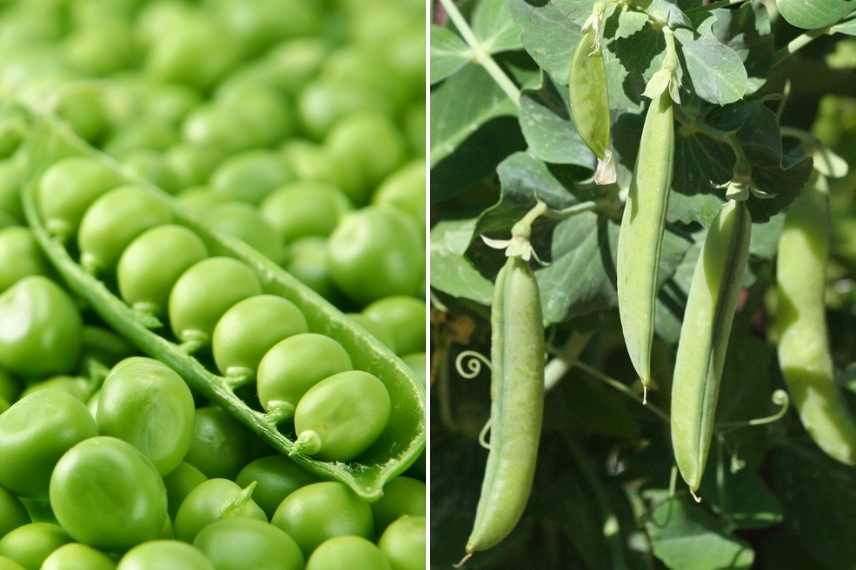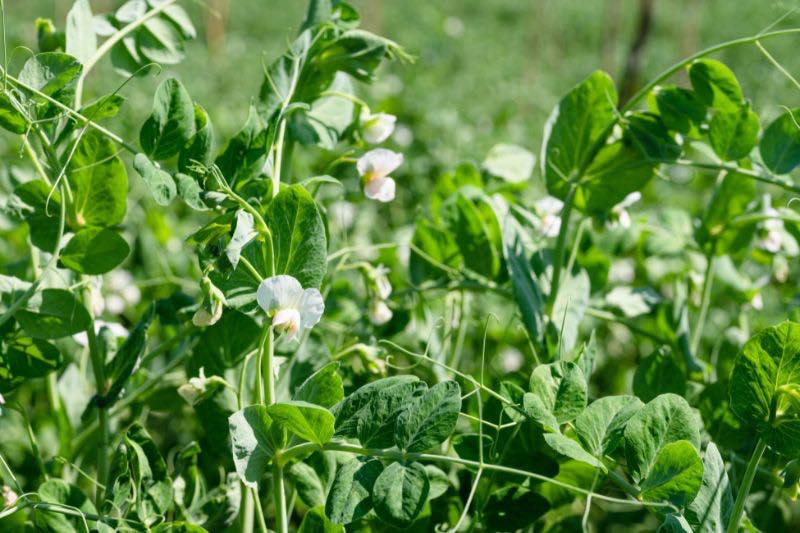Peas are one of the most popular and easiest vegetables to grow in a vegetable garden. Rich in nutrients, fibre and plant protein, they naturally belong in spring crops. Growing and sowing peas in the vegetable patch lets you enjoy fresh, tasty vegetables throughout the pea season. In this guide, discover how to sow peas, when to sow peas outdoors, and all the best practices to succeed with this sowing. From choosing seeds to the harvest of peas, and the care needed for climbing peas or dwarf varieties, we explain everything step by step. Whether you are starting out or used to planting peas, you will find useful tips to get lovely pea shoots and make the most of them!
Which peas to sow?
| Type of pea | Characteristics | Sowing / Harvest |
| Dwarf peas | Max height 50–60 cm, no staking required. Perfect for small spaces. | Sowing: Feb–Apr / Harvest: May–Jul |
| Climbing peas | Climb up to 2 m. Need support. Generous long-term production. | Sowing: Feb–Apr / Harvest: Jun–Aug |
| Shelling peas | Only seeds are eaten. Pods are tough. Very sweet and flavoursome. | Sowing: Feb–Apr / Harvest: May–Jul |
| Mangetout or garden peas* | Whole pod and seeds are eaten. Harvest young. Very tender and crunchy. | Sowing: Feb–Apr / Harvest: May–Jun (early) |
*There are also crunchy or sugar-snap peas resulting from cross-breeding between a traditional pea and a mangetout. The pod is thicker and the peas larger than on a standard mangetout.

Where to sow peas?
Peas are plants that prefer cool, moist climates. They will grow in full sun or in partial shade. They need light to develop but can be damaged by high temperatures and strong direct sun. In short, favour full sun in the north and partial shade in the south.
Peas grow best in well-drained soil, rich in organic matter and slightly acidic (pH between 6 and 7). Avoid sowing peas in compacted or waterlogged soil, as this can cause rot and mould problems.
Tip: Peas can be sown directly outdoors or in pots or containers on a balcony or terrace.
Warning! Peas like the company of turnips, radishes, carrots or potatoes, but will not tolerate being sown near alliaceous crops such as onion, shallot or garlic.
When to sow peas outdoors?
Peas can be grown in a wide range of climates, but sowing time varies with growing zone and local weather. In general, peas are sown in spring (between February and April) when soil has warmed sufficiently and risk of late frost has passed. For an early harvest, round-seeded peas (smooth seeds) can be sown in October–November and again from February. Wrinkled-seed peas can be sown between February and late May. Bear in mind that peas dislike high heat, so avoid sowing too late. Germination takes about 10–15 days if soil temperature averages 10 °C.
Ideal temperatures for good pea growth are 18–23 °C by day and 8–10 °C at night. To help, you can sow peas under a plastic tunnel and remove it once seedlings have emerged. Note that pea leaves tolerate negative temperatures around −5 °C to −10 °C.
Peas are fast-growing plants, but it is important to sow seeds early in the season to ensure they have enough time to develop before summer heat. As a rule, sow peas every two weeks to spread the harvest over a longer period.
Note that wrinkled-seed peas tend to have lower germination than smooth-seed peas due to their thicker seed coat. For this reason, sow wrinkled-seed peas slightly deeper than smooth-seed peas to ensure even and rapid germination. You can also soak wrinkled seeds for a few hours in water before planting to improve germination.

How to sow peas?
Equipment needed for sowing peas
- Garden rake
- Spade or digging fork or aero-fork / biofork
- Hoe or hand hoe to make furrows
- Watering can
- Gardening gloves
- Trellis, netting or wire mesh and bamboo canes
Here are the basic steps to sow peas :
- Soil preparation: Remove stones, debris and weeds and loosen soil with a digging fork, then level with a rake. You can also grow peas in a planter box; favour dwarf peas for containers;
- Sowing: Create furrows 3–5 cm deep and about 5 cm wide, spaced 30–40 cm apart. Place pea seeds every 5–8 cm along the furrows. For wrinkled-seed peas, sow seeds a little deeper. Cover seeds with fine soil and press lightly;
- Watering: Pea shoots need a good amount of water to develop, especially during hot, dry periods. Water lightly to keep soil moist but not waterlogged. Avoid heavy watering which could displace seeds;
Pea harvest
Long live the pea season! Peas are ready to harvest approximately 60–80 days after planting, depending on variety. Harvest peas regularly to encourage continuous production and to prevent pods becoming over-mature and fibrous.
Care after sowing peas
Peas also need support to climb, such as a trellis, canes or netting for climbing peas, and a low mesh or a few branches for dwarf peas (just to keep them upright). You can also mulch the soil to keep roots cool and moist and to prevent weeds. By following these steps, you should be able to sow peas successfully and enjoy delicious fresh vegetables from your garden.
































![[planting_guide product="petits-pois"]
Sowing Peas](https://en.promessedefleurs.eu/blogwp/wp-content/uploads/2023/03/Comment-semer-des-petits-pois-.png)
Comments